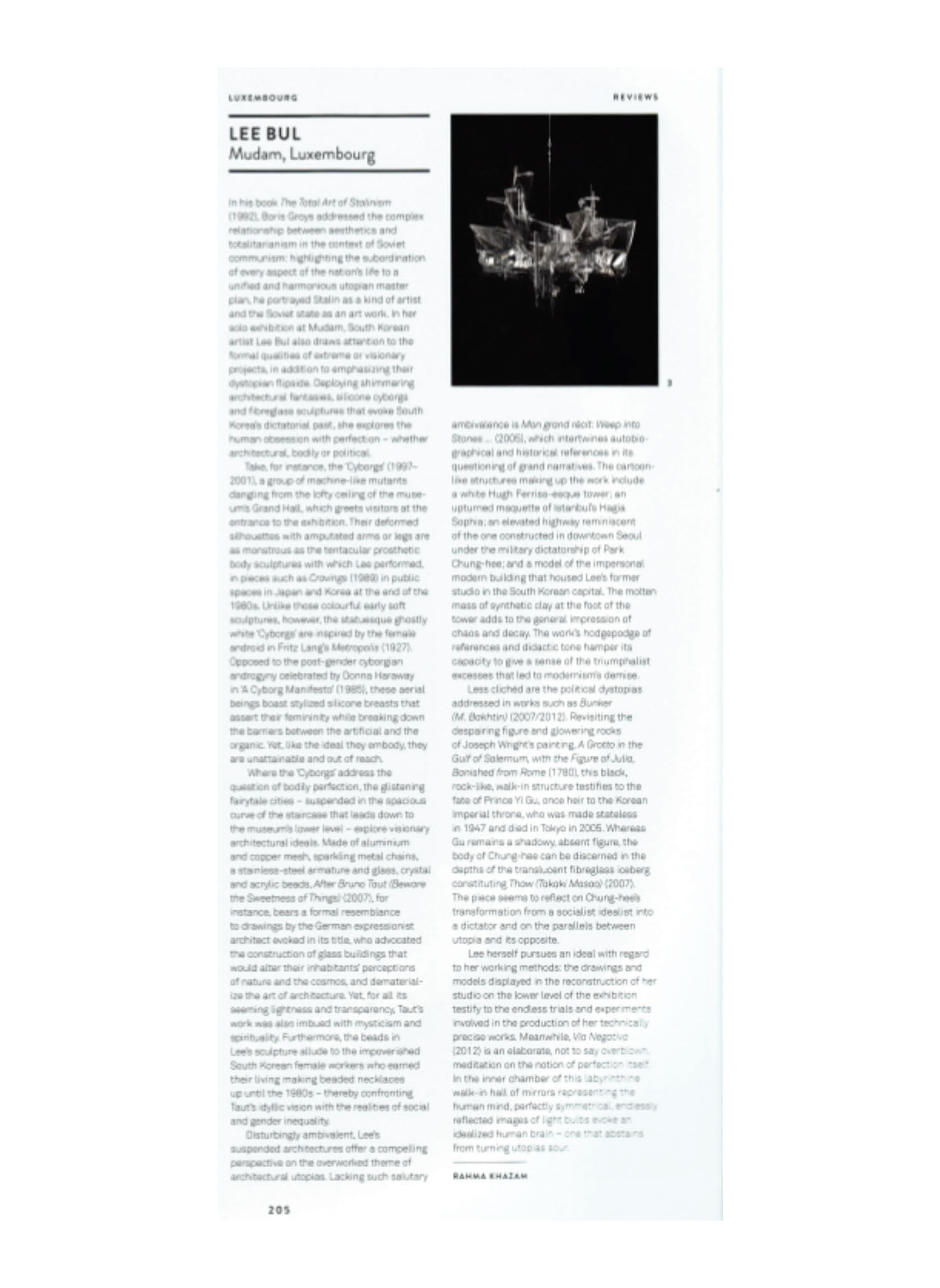
Lee Bul

In his book The Total Art of Stalinism (1992), Boris Groys addressed the complex relationship between aesthetics and totalitarianism in the context of Soviet communism: highlighting the subordination of every aspect of the nation’s life to a unified and harmonious utopian master plan, he portrayed Stalin as a kind of artist and the Soviet state as an art work. In her solo exhibition at Mudam, South Korean artist Lee Bul also draws attention to the formal qualities of extreme or visionary projects, in addition to emphasizing their dystopian flipside. Deploying shimmering architectural fantasies, silicone cyborgs and fibreglass sculptures that evoke South Korea’s dictatorial past, she explores the human obsession with perfection – whether architectural, bodily or political.
Take, for instance, the ‘Cyborgs’ (1997–2001), a group of machine-like mutants dangling from the lofty ceiling of the museum’s Grand Hall, which greets visitors at the entrance to the exhibition. Their deformed silhouettes with amputated arms or legs are as monstrous as the tentacular prosthetic body sculptures with which Lee performed, in pieces such as Cravings (1989) in public spaces in Japan and Korea at the end of the 1980s. Unlike those colourful early soft sculptures, however, the statuesque ghostly white ‘Cyborgs’ are inspired by the female android in Fritz Lang’s Metropolis (1927). Opposed to the post-gender cyborgian androgyny celebrated by Donna Haraway in ‘A Cyborg Manifesto’ (1985), these aerial beings boast stylized silicone breasts that assert their femininity while breaking down the barriers between the artificial and the organic. Yet, like the ideal they embody, they are unattainable and out of reach.
Where the ‘Cyborgs’ address the question of bodily perfection, the glistening fairytale cities – suspended in the spacious curve of the staircase that leads down to the museum’s lower level – explore visionary architectural ideals. Made of aluminium and copper mesh, sparkling metal chains, a stainless-steel armature and glass, crystal and acrylic beads, After Bruno Taut (Beware the Sweetness of Things) (2007), for instance, bears a formal resemblance to drawings by the German expressionist architect evoked in its title, who advocated the construction of glass buildings that would alter their inhabitants’ perceptions of nature and the cosmos, and dematerialize the art of architecture. Yet, for all its seeming lightness and transparency, Taut’s work was also imbued with mysticism and spirituality. Furthermore, the beads in Lee’s sculpture allude to the impoverished South Korean female workers who earned their living making beaded necklaces up until the 1980s – thereby confronting Taut’s idyllic vision with the realities of social and gender inequality.
Disturbingly ambivalent, Lee’s suspended architectures offer a compelling perspective on the overworked theme of architectural utopias. Lacking such salutary ambivalence is Mon grand récit: Weep into Stones ... (2005), which intertwines autobiographical and historical references in its questioning of grand narratives. The cartoon-like structures making up the work include a white Hugh Ferriss-esque tower; an upturned maquette of Istanbul’s Hagia Sophia; an elevated highway reminiscent of the one constructed in downtown Seoul under the military dictatorship of Park Chung-hee; and a model of the impersonal modern building that housed Lee’s former studio in the South Korean capital. The molten mass of synthetic clay at the foot of the tower adds to the general impression of chaos and decay. The work’s hodgepodge of references and didactic tone hamper its capacity to give a sense of the triumphalist excesses that led to modernism’s demise.
Less clichéd are the political dystopias addressed in works such as Bunker (M. Bakhtin) (2007/2012). Revisiting the despairing figure and glowering rocks of Joseph Wright’s painting, A Grotto in the Gulf of Salernum, with the Figure of Julia, Banished from Rome (1780), this black, rock-like, walk-in structure testifies to the fate of Prince Yi Gu, once heir to the Korean Imperial throne, who was made stateless in 1947 and died in Tokyo in 2005. Whereas Gu remains a shadowy, absent figure, the body of Chung-hee can be discerned in the depths of the translucent fibreglass iceberg constituting Thaw (Takaki Masao) (2007). The piece seems to reflect on Chung-hee’s transformation from a socialist idealist into a dictator and on the parallels between utopia and its opposite.
Lee herself pursues an ideal with regard to her working methods: the drawings and models displayed in the reconstruction of her studio on the lower level of the exhibition testify to the endless trials and experiments involved in the production of her technically precise works. Meanwhile, Via Negativa (2012) is an elaborate, not to say overblown, meditation on the notion of perfection itself. In the inner chamber of this labyrinthine walk-in hall of mirrors representing the human mind, perfectly symmetrical, endlessly reflected images of light bulbs evoke an idealized human brain – one that abstains from turning utopias sour.
